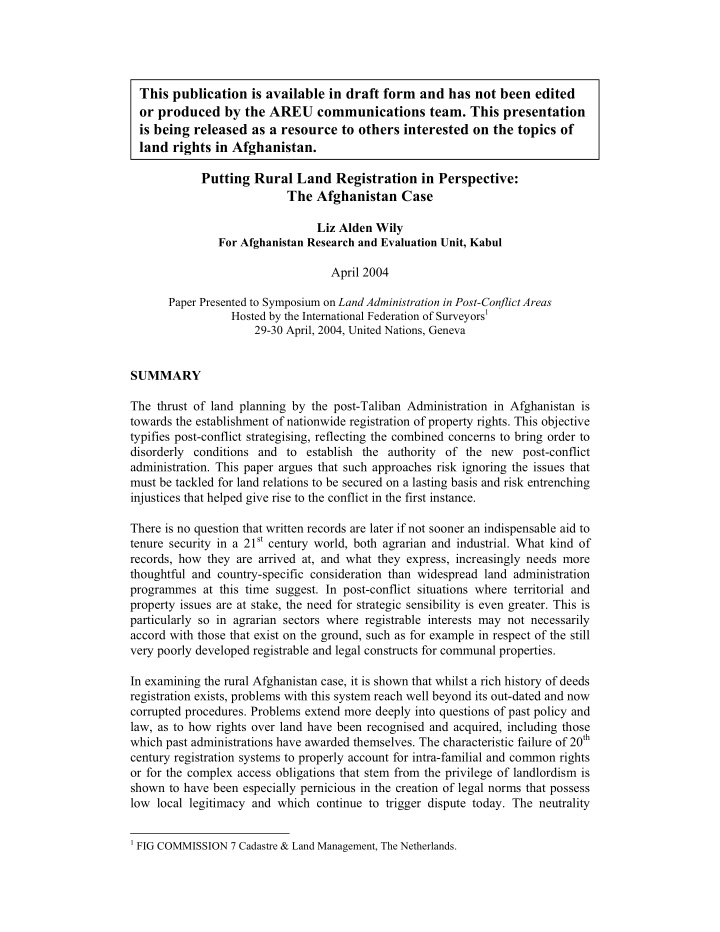



This publication is available in draft form and has not been edited or produced by the AREU communications team. This presentation is being released as a resource to others interested on the topics of land rights in Afghanistan. Putting Rural Land Registration in Perspective: The Afghanistan Case Liz Alden Wily For Afghanistan Research and Evaluation Unit, Kabul April 2004 Paper Presented to Symposium on Land Administration in Post-Conflict Areas Hosted by the International Federation of Surveyors 1 29-30 April, 2004, United Nations, Geneva SUMMARY The thrust of land planning by the post-Taliban Administration in Afghanistan is towards the establishment of nationwide registration of property rights. This objective typifies post-conflict strategising, reflecting the combined concerns to bring order to disorderly conditions and to establish the authority of the new post-conflict administration. This paper argues that such approaches risk ignoring the issues that must be tackled for land relations to be secured on a lasting basis and risk entrenching injustices that helped give rise to the conflict in the first instance. There is no question that written records are later if not sooner an indispensable aid to tenure security in a 21 st century world, both agrarian and industrial. What kind of records, how they are arrived at, and what they express, increasingly needs more thoughtful and country-specific consideration than widespread land administration programmes at this time suggest. In post-conflict situations where territorial and property issues are at stake, the need for strategic sensibility is even greater. This is particularly so in agrarian sectors where registrable interests may not necessarily accord with those that exist on the ground, such as for example in respect of the still very poorly developed registrable and legal constructs for communal properties. In examining the rural Afghanistan case, it is shown that whilst a rich history of deeds registration exists, problems with this system reach well beyond its out-dated and now corrupted procedures. Problems extend more deeply into questions of past policy and law, as to how rights over land have been recognised and acquired, including those which past administrations have awarded themselves. The characteristic failure of 20 th century registration systems to properly account for intra-familial and common rights or for the complex access obligations that stem from the privilege of landlordism is shown to have been especially pernicious in the creation of legal norms that possess low local legitimacy and which continue to trigger dispute today. The neutrality 1 FIG COMMISSION 7 Cadastre & Land Management, The Netherlands.
2 classically accorded formal procedures and assumptions as to the sanctity of title deeds are also challenged. For many rural Afghans, paper entitlements to especially pasture represents less evidence of due right than evidence of an intolerable oppression, and resistance to which has been integral to the conflicts of the last quarter century up until the present. In short, the search for peace and acceptable tenure are inextricably linked and unlikely to be well-served by rigid perseverance with bureaucratic procedure, the resulting illusion of increased order notwithstanding. A fresh approach is required and which is able to absorb the lessons of local history on the one hand, and able to work around the realities posed by limited rule of law or confidence in the courts to uphold rights fairly. To this end a community based approach is suggested. This would facilitate trial establishment of locally run mechanisms for resolving conflicts over pasture with all concerned actors and establishing community based land ownership regulation and management. Atypically, the approach would need to begin, not end, with common rather than individually-held properties like the farm and house. For it is the commons – and mainly pastures – which generate the most contentious and inflammatory communal conflicts at this time. It also in relation to pasture that state, common and private interests so heatedly battle for space and meaning and require unpacking and reordering towards more acceptable norms, and where the current legal paradigm in which Government positions itself as owner of all pasture, is contested. Face-to-face reconciliation in respect of specific pastures could begin by setting aside the question as to who owns pasture with a focus upon rationalising the use, access and regulation of the pasture, and towards establishing the mechanisms for sustaining the norms agreed. It is these agreements and procedures (or rights and rules) that would first be recorded, laying the foundation for a local land access register and locally- administered land governance system in respect of pastures and other non- individually used or held estates. Such pilot developments, targeting a systematic range of disputed pastures, will provide practical building blocks towards the definition of new rural land policy and law. This will include clarification of workable distinctions between state, private and common properties, and workable procedures for localised land administration in general. Genuinely local ownership of the process and subsequent institutional developments, will greatly advance the workability and sustainability of new tenure administration. Key Words : communal conflict, pastoral rights, common property, community based land administration 1. THE SITUATION 1.1. The State The modern state of Afghanistan began to take shape in the 18 th century in the founding of the Durrani Empire, an alliance of Pushtun tribes south of the Hindu Kush mountain range who appointed an Amir (King) to coordinate their interests. 2 A century later (1892) Amir Abdur al Rahman of Kabul had conquered areas around and 2 Olesen 1995. Pushtun tribes in Afghanistan broadly divide into Durrani and Ghilzai. ____________________________________________________________________________________ Alden Wily for AREU Symposium on Land Administration in Post-Conflict Areas, April 29-30, 2004, Geneva
Recommend
More recommend